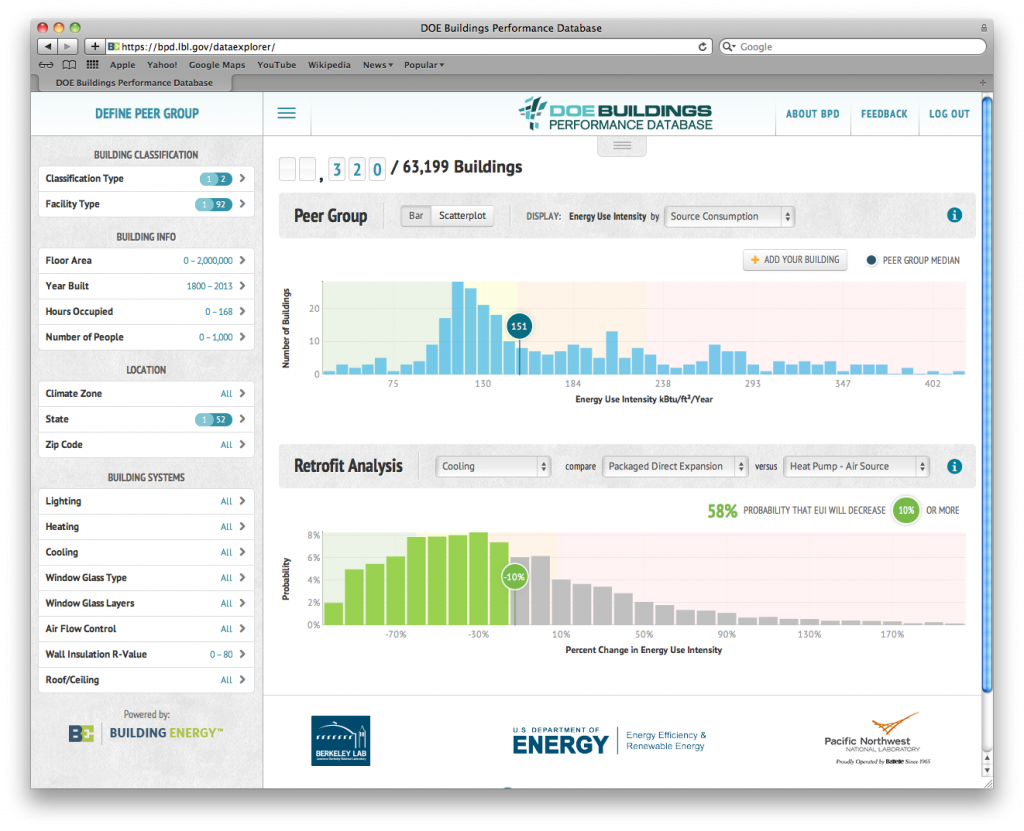A new database of building features and energy use data helps building managers, owners, real estate investors, and lenders evaluate the financial results of energy efficiency investment projects and identify high and low-performing buildings.
The U.S. Department of Energy’s Building Performance Database (BPD) is being developed by a team of researchers at Lawrence Berkeley National Laboratory’s (Berkeley Lab) Environmental Energy Technologies Division led by Staff Scientist Paul Mathew. Berkeley Lab is partnering with Building Energy Inc. (Portland, OR) for the software implementation. Building Energy Inc. specializes in software solutions to integrate disparate building energy use and characteristics datasets.
 “The real estate investment community, building managers, and owners asked the Department of Energy for a tool to help them better evaluate the financial costs and benefits of energy efficiency projects in buildings, to help them guide investment decisions. DOE responded by establishing the Buildings Performance Database, which we are developing under their direction,” says Mathew.
“The real estate investment community, building managers, and owners asked the Department of Energy for a tool to help them better evaluate the financial costs and benefits of energy efficiency projects in buildings, to help them guide investment decisions. DOE responded by establishing the Buildings Performance Database, which we are developing under their direction,” says Mathew.
The database contains real performance data from more than 60,000 buildings across the United States from both public and private datasets—not modeled data. BPD currently contains basic building data such as gross floor area, years built and hours occupied, and energy performance metrics, including energy use intensity (for example, kilowatt-hours per square foot), source and site energy consumption, and electricity and fuel consumption. The data have been stripped of identifying characteristics such as street addresses to preserve business confidential information, to encourage as many private sources to contribute to BPD as possible.
“Development of the BPD is ongoing,” says Mathew. “More types of information, such as building assets and equipment, and metered interval data from utilities, will become available as the BPD grows.”
BPD also has a tool to make using the dataset easy, with more features planned for future releases. The data explorer feature allows users to compare the energy use of their own buildings to a set of BPD buildings they can choose by such parameters as building type, floor area, age, and occupancy, and by system features such as lighting and HVAC. The tool allows users to create graphs comparing the energy use of their buildings to the building peer group the user has created. [See illustration.]
The latest release of the tool includes a retrofit analysis feature, which compares the energy use of buildings with different technologies. The tool provides users with the probability of achieving different levels of energy savings for retrofits.
The database features an application programming interface (API) that allows external software developers to access the data and incorporate analytical results into their own tools.
“We are building this database to meet the needs of the buildings community—of investors, owners, and building managers, as well as energy efficiency program managers, and local, state and federal government agencies that manage buildings,” says Mathew. “The capabilities we’re building into the database allow them not only to assess the potential savings from energy performance upgrades, but to increase confidence that planned projects will meet their goals.”
The investment community can use the BPD to help quantitatively distinguish between the expected returns from projects, and their performance risk. Investors will have the information they need to diversify the risk in their portfolios by investing a range of buildings and energy performance project types.
In addition to assessing project opportunities and performance risk, energy efficiency program managers and building managers in federal state and local governments can also use BPD to compare the performance of efficiency projects in their portfolio, and perhaps, to influence local real estate markets to undertake efficiency performance improvements by sharing data about their projects without revealing building-level information.
“As we add more datasets and functionality, we expect that the Building Performance Database will become an essential tool for the buildings and financial industries. It will help provide the confidence in rates of return from energy efficiency performance investments in buildings to help these investments, and the economic benefits and job growth they bring, to expand,” Mathew says.
This research is funded by the U.S. Department of Energy’s Office of Energy Efficiency and Renewable Energy.
Building Performance Database: https://www1.eere.energy.gov/buildings/commercial/bpd.html
Interested buildings professionals can sign on to become BPD users at this site.
# # #
Lawrence Berkeley National Laboratory addresses the world’s most urgent scientific challenges by advancing sustainable energy, protecting human health, creating new materials, and revealing the origin and fate of the universe. Founded in 1931, Berkeley Lab’s scientific expertise has been recognized with 13 Nobel prizes. The University of California manages Berkeley Lab for the U.S. Department of Energy’s Office of Science. For more, visit www.lbl.gov.
